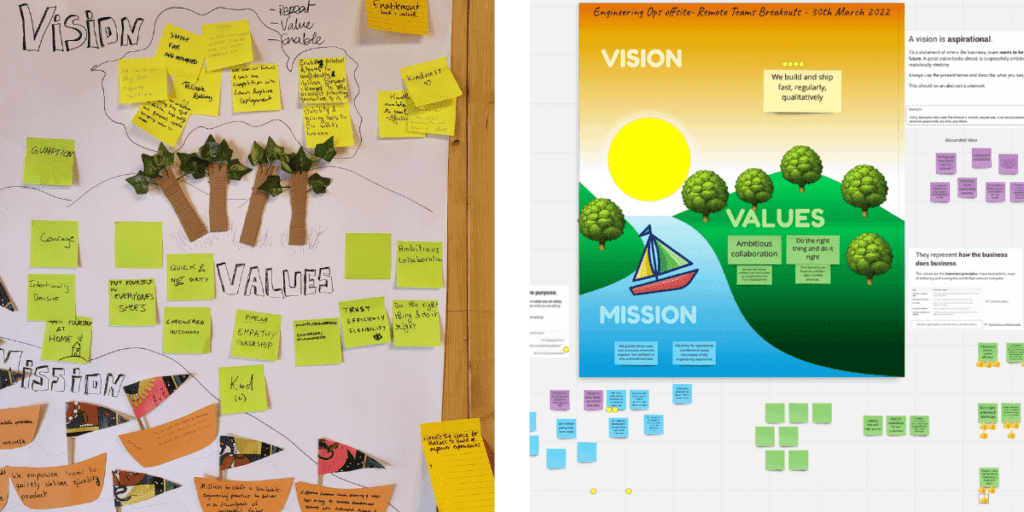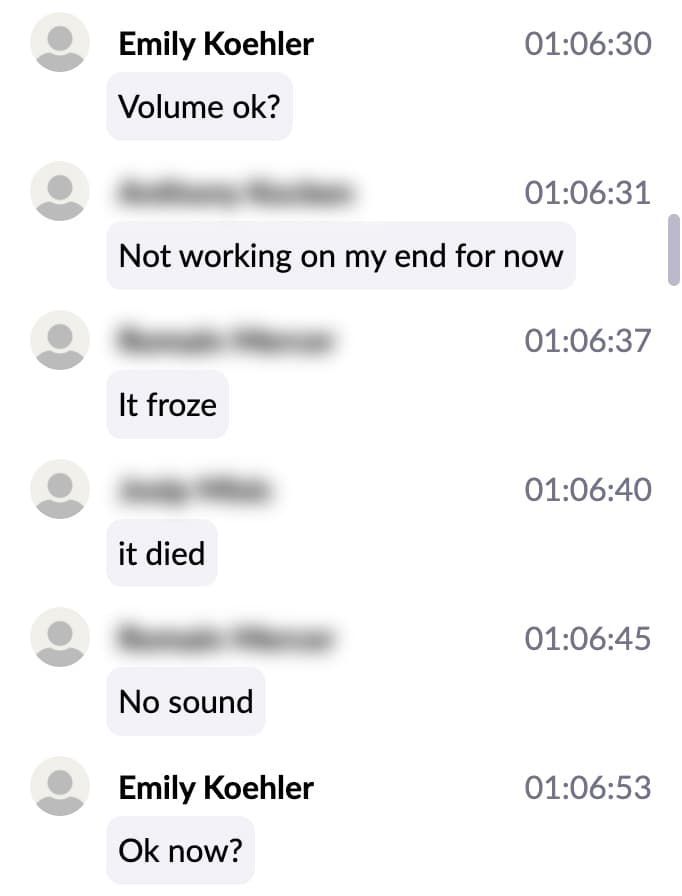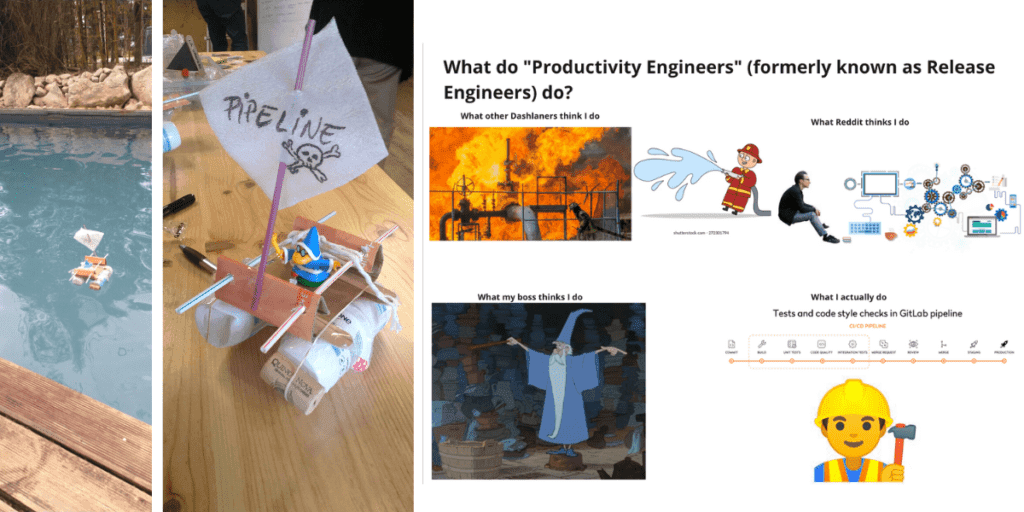What We Learned from Running Our First Hybrid Team Offsite
This past month, Dashlane's Engineering Operations team (EngOps) held its inaugural offsite event. While most participants were able to be there in person, there was also a smaller contingent joining the sessions remotely. Having a hybrid event presents special challenges, and after this event, we're ready to share what we got right, what we got wrong, and list out some takeaways you can use to guide your own hybrid event planning.
To start, form must follow function. Before we could plan the events of the offsite we needed to establish our goals. We determined that at the offsite we wanted to achieve three things:
- Co-create the team's mission and value system
- Build meaningful connections as a group
- Set roles & responsibilities for our staff within the greater Engineering team
The first and third items on the list were both achievable through a combination of activities and discussions among participants which resulted in the creation of a shared artifact. We could go through the paces of defining "What are the values of the EngOps team?" then discuss, present and edit them into a neatly typed page we can keep in Confluence for all our friends to read. Similarly, setting roles and responsibilities took the form of career pathing discussions and talks about how we might better collaborate with the broader Engineering department. A revised career path is one form of artifact coming out of the offsite, as are decisions made about what EngOps will and won't do in relation to its Engineering counterparts. All these discussions produced tangible "stuff" we could take back from the offsite and back to our day-to-day jobs.
Not so with item two: Build meaningful connections. It's simply not as easy to do with hybrid attendance, and we probably could have done more in this arena.
What we got right
- There were dedicated calendar invitations with Zoom rooms set up for each session. Activity facilitators made sure to create equivalent Miro boards for remote attendees, while in-person joiners used traditional poster boards. Using the same prompts, board format and breakout group style meant attendees could all "report back" their ideas to the larger group in the same way. Someone from the in-person group was adding the remote teams' contributions to the 'main' board throughout, so at the end of the day we created one shared board.
- Audience participation tools like https://www.sli.do/ were equally easy to use for those in-person and at home. Quizzing attendees to gauge understanding of topics being presented helped keep engagement levels high.
- The best feedback received from remote joiners was about our choice to keep the breakout groups completely separate between those participating in-person and those joining remotely. Remote folks felt productive and capable in their remote-only breakout activities, but when combined with the in-person group for report-outs or Q&A, began to feel like an afterthought. We could have used a dedicated in-person attendee watching the zoom chat to make sure remote folks had priority to ask questions. This might have counter-balanced presenters' tendency to answer who they could hear more easily: the unmuted live audience.
Example: Mission/ Vision/ Values exercise in-person (left) vs remote (right):

What we got wrong
- Remote attendees occasionally felt like annoyances since they were always asking the in-person folks to adjust the camera, speak more loudly, share the screen properly, or repeat what they had said once again, even though there were multiple laptops set up on Zoom to capture the presenter, for the Presenter to share their screen, and in many cases, there was a third laptop to get a shot of the attendees
- We simply needed better audio-visual equipment.
- The microphones on our laptops were insufficiently sensitive to pick up on questions coming from in-person attendees. It added a delay to the Q&A portion of the talks, since presenters needed to listen to questions in classic Charlie Brown teacher style "womp womp womp woooomp" and then repeat it for the remote audience, and then answer the question. And then the process would repeat itself. Sheesh.
- There was only one projection screen in the main activity room for in-person participants, meaning that if someone was presenting a deck, the in-person crowd would see the deck content but could not see the faces of their remote colleagues. This provided for a range of sometimes hilarious and often frustrated reactions ("SOS, can't hear you!") whilst there was no dedicated watcher on the chat.
- The microphones on our laptops were insufficiently sensitive to pick up on questions coming from in-person attendees. It added a delay to the Q&A portion of the talks, since presenters needed to listen to questions in classic Charlie Brown teacher style "womp womp womp woooomp" and then repeat it for the remote audience, and then answer the question. And then the process would repeat itself. Sheesh.
- There was only one projection screen in the main activity room for in-person participants, meaning that if someone was presenting a deck, the in-person crowd would see the deck content but could not see the faces of their remote colleagues. This provided for a range of sometimes hilarious and often frustrated reactions ("SOS, can't hear you!") whilst there was no dedicated watcher on the chat.
- The microphones on our laptops were insufficiently sensitive to pick up on questions coming from in-person attendees. It added a delay to the Q&A portion of the talks, since presenters needed to listen to questions in classic Charlie Brown teacher style "womp womp womp woooomp" and then repeat it for the remote audience, and then answer the question. And then the process would repeat itself. Sheesh.
- There was only one projection screen in the main activity room for in-person participants, meaning that if someone was presenting a deck, the in-person crowd would see the deck content but could not see the faces of their remote colleagues. This provided for a range of sometimes hilarious and often frustrated reactions ("SOS, can't hear you!") whilst there was no dedicated watcher on the chat.

Is a hybrid offsite right for your team?
In evaluating the success of our own offsite, we've given some thought as to how other teams could better prepare for their own.
1: The goals you have for the offsite need to be achievable for all attendees, or you need to relax expectations for having all groups get the same outcomes. As we mentioned already, it's one thing to facilitate an activity to share information or produce shared artifacts on Zoom, but it is quite another to build meaningful connections. Few Zoom interactions can match the bonding power of a spontaneous and well timed happy hour joke, or the shared elation of a team's icebreaker challenge victory.
Consider how the participants must have felt watching this winning team's upcycled boat setting sail in the hotel pool. On the other hand, remote attendees were creating meme boards, which despite being genuinely creative and funny, can't match the same level of emotional engagement required to design and sail an upcycled boat from yogurt cups and plastic bags.

2: You need more time, people, and supplies than you probably think
- People: In running this offsite we realised that there were many moments where two fully dedicated facilitators were needed for each session, one for in-person and one for online. This was in addition to presenters themselves.
- Time: In-person attendees needed to have booked rooms, pre-arranged meal breaks, and someone fielding folks from one place to another to keep on schedule, lest the remote attendees be left waiting in an empty zoom room.
- Supplies: Secure the proper cameras, microphones, multiple projector screens and dedicated camera people to ensure remote attendees can hear and speak just as freely as those in-person.
3: Establishing hubs for communication
Just as there were separate groups between the in-person and remote attendees, so were there separate Slack channels, and separate Zoom breakout rooms. This way the remote attendees could manage conversations and screen-sharing for activities with some level of independence. Meanwhile, the in-person crowd also had a WhatsApp group put together for notifications about lodgings, food and activities happening IRL. To have easy access to offsite content, the organising group added all of the presentations and worksheets to a Google Drive folder shared among participants.
Running an offsite is no trivial affair, especially with the constraints and special considerations of a hybrid workforce. Hopefully these insights will both help provoke ideas and avoid pitfalls for your next team event. Happy planning!
Sign up to receive news and updates about Dashlane
